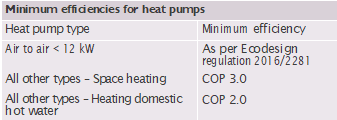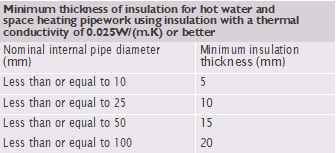What heating engineers need to know about important new changes to building regulations
What heating engineers need to know about important new changes to building regulations
OFTEC technical manager, Joe Bath presents an overview of significant changes to building regulations that will affect all heating engineers working in England.
Someone once told me: “Change is like manure – it stinks but it helps you grow”. This sentiment neatly summarises upcoming changes to guidance on Part L of the Building Regulations. Changing guidance is a headache, as it forces us to work in new and unfamiliar ways. However, learning new ways of working is an excellent way to upskill.
We have known for some time that due to the Government’s legal obligations to decarbonise all sectors, significant changes to the heating industry are coming. In England, these changes start on 15 June 2022. On this date, newly published ‘Approved Documents’ detailing enhanced energy efficiency requirements come into force. These changes are described as an ‘uplift’ in energy efficiency. This ‘uplift’ is a steppingstone to further far-reaching changes in 2025. There is no doubt that the newly published Approved Document L Volumes 1 & 2 will require all heating engineers to change and upskill. These documents are free to download from GOV.UK. You can access and download and/or print versions of the documents here.
What are the significant changes you need to know about? The main changes affecting technicians working in dwellings are presented below.
Until now, most guidance for heating engineers has not been in Approved Documents themselves but in separate guides titled Domestic Building Services Compliance Guide and Non-Domestic Building Services Compliance Guide. From June, these documents no longer exist for use in England. All guidance is now contained in the Approved Documents (which is why you should get a copy).
Newly installed heating systems and completely replaced heating systems (including the heating appliance, heat emitters and pipework) should be designed to run at a maximum flow temp of 55°C. This uplift is designed to ensure heating systems installed from June onwards are suitable for heat pumps later. This might require some upskilling for heating engineers, as pipe and radiator sizing will need to be carefully specified to ensure enough heat is provided to each room. I strongly recommend you dig out your copy of the Domestic Heating Design Guide to remind yourself on how to do this. OFTEC will endeavour to provide a calculator to aid radiator selection.
Believe it or not, for the first time, Approved Documents state that heating systems should be based on building- specific heat loss calculations, and hot water storage should be based on anticipated demand. Neither should be oversized. On this basis, installers will need to ensure they keep records of such calculations to demonstrate compliance.

In exceptional circumstances, where the criteria of the ‘Guide to condensing boiler installation assessment procedure for dwellings’ is met, minimum efficiencies are 84% (SEDBUK 2009) for a regular boiler or 82% for a combi-boiler.
For some time, it has been a requirement that before replacing a domestic primary heating appliance with an appliance that runs on a different fuel, you should compare the carbon emissions of the new appliance to that of the existing appliance and then consider whether the appliance replacement is permissible. This process has been strengthened. A second calculation has been added to verify that the replacement appliance will not have a higher primary energy demand. This means that all the following must be true for a compliant appliance replacement:

Heat pumps are exempt from this calculation if they meet the minimum efficiencies in the table to the right. The Approved Documents explain how to compare emissions and primary energy using fuel factors and a mathematical calculation – it is not straightforward!
To assist technicians, OFTEC will be updating Technical Notice 033 and the calculation tool that does the maths for you, currently both hosted in the registered technicians’ section of www.oftec.org.
Where replacing an appliance with one using the same fuel, the new appliance must be at least as efficient as the minimum efficiencies in the tables above and at least as efficient as the appliance being replaced.
Guidance on the installation of appliance types B1,B2,B3 (open fires), C1,C2 (open fire and non-high output boiler), and J3,J4 (multifuel or anthracite boilers) are no longer listed as suitable to install. This represents any appliance that can burn mineral fuels. OFTEC is seeking clarification about whether this means such appliances cannot be installed or whether this is designed to steer installers away from such products.
Heat pumps should be selected to meet the full space heating requirement at the design condition chosen for heat loss calculations. Where there are other heat sources available in a building with a heat pump, each of these heat sources should be appropriately incorporated into a singular control system.
Heat pumps should not be sited adjacent to sleeping areas or on materials that can readily transmit vibrations. Additionally, the location of external fans and heat pump compressors should be appropriately selected to minimise disturbance to neighbours, while remaining in compliance with planning requirements.
Commissioning information for the ground arrays of a ground source heat pumps has been updated.
Where a heating system is installed or a boiler replaced, in nearly every case, each room should be provided with thermostatic room controls. This can be achieved by one of the following:
Secondary DHW circuits should be timed separately from space heating. Where working on an existing system, if domestic hot water and space heating are controlled by a single time controller, then these may continue to be controlled together after the work is complete.

The table to the right shows the minimum thickness of insulation required for heating and hot water pipework. Note that this is for insulation with a thermal conductivity of 0.025W/(m.K) or better. If insulation with worse performance is used, then BS 5422 will need to be consulted.
Underfloor heating pipework that does not contribute useful heat to a room should be insulated. The option to run in conduit is removed.
Guidance makes clear that installers and commissioning technicians need to issue and/or handover all relevant paperwork, such as installation completion reports, commissioning reports, manufacturer’s instructions, product fiches, energy labels and ErP package labels whenever they install appliances or heating systems, change heating fuel, or extend/expand the capacity of a space heating system by more than 25%.
Hopefully, this article has given you a flavour of the changes coming on 15 June 2022. I strongly recommend you download the new Approved Documents and use them as guides to assist you with quoting for work that will commence after this date. OFTEC’s hardworking technical department will continue to review the new guidance and will issue helpful tools and Technical Notices to ensure technicians working at dwellings and buildings other than dwellings are well informed and compliant.
Building regulations themselves contain little detail. As a result, it can be difficult for installers to know whether they have met the requirements of building regulations without further guidance.
Approved Documents are published by government and give practical guidance on common building situations about how to meet the requirements of the building regulations. From 15 June 2022 the newly published ‘Approved Document L Volume 1: Dwellings’ and ‘Approved Document L Volume 2: Buildings Other Than Dwellings’ provides the guidance that installers should follow to be confident they have met the requirements of building regulations. OFTEC requires installers to comply with the guidance in Approved Documents.
© 2025 Created by Euromedia Associates Ltd